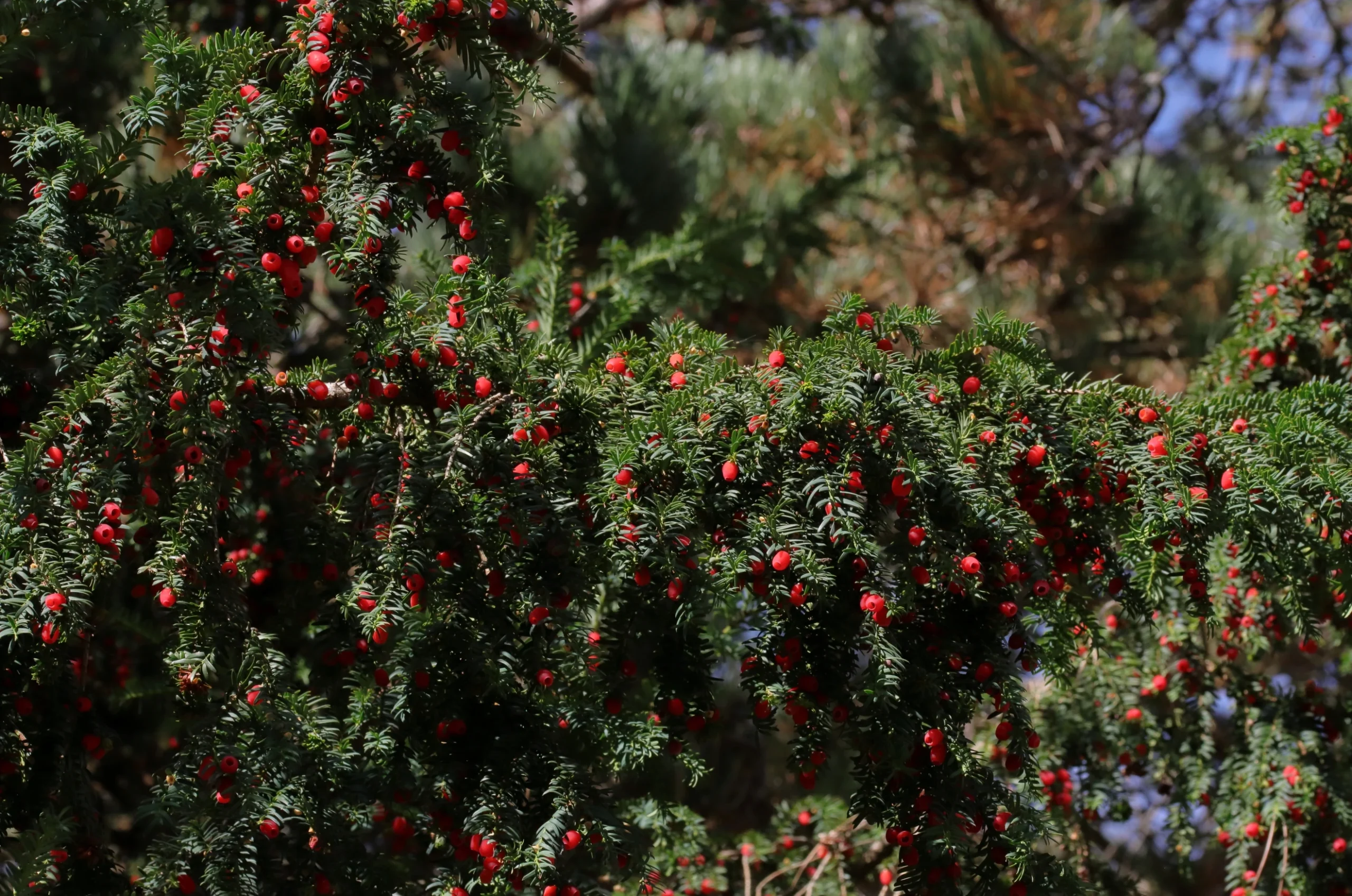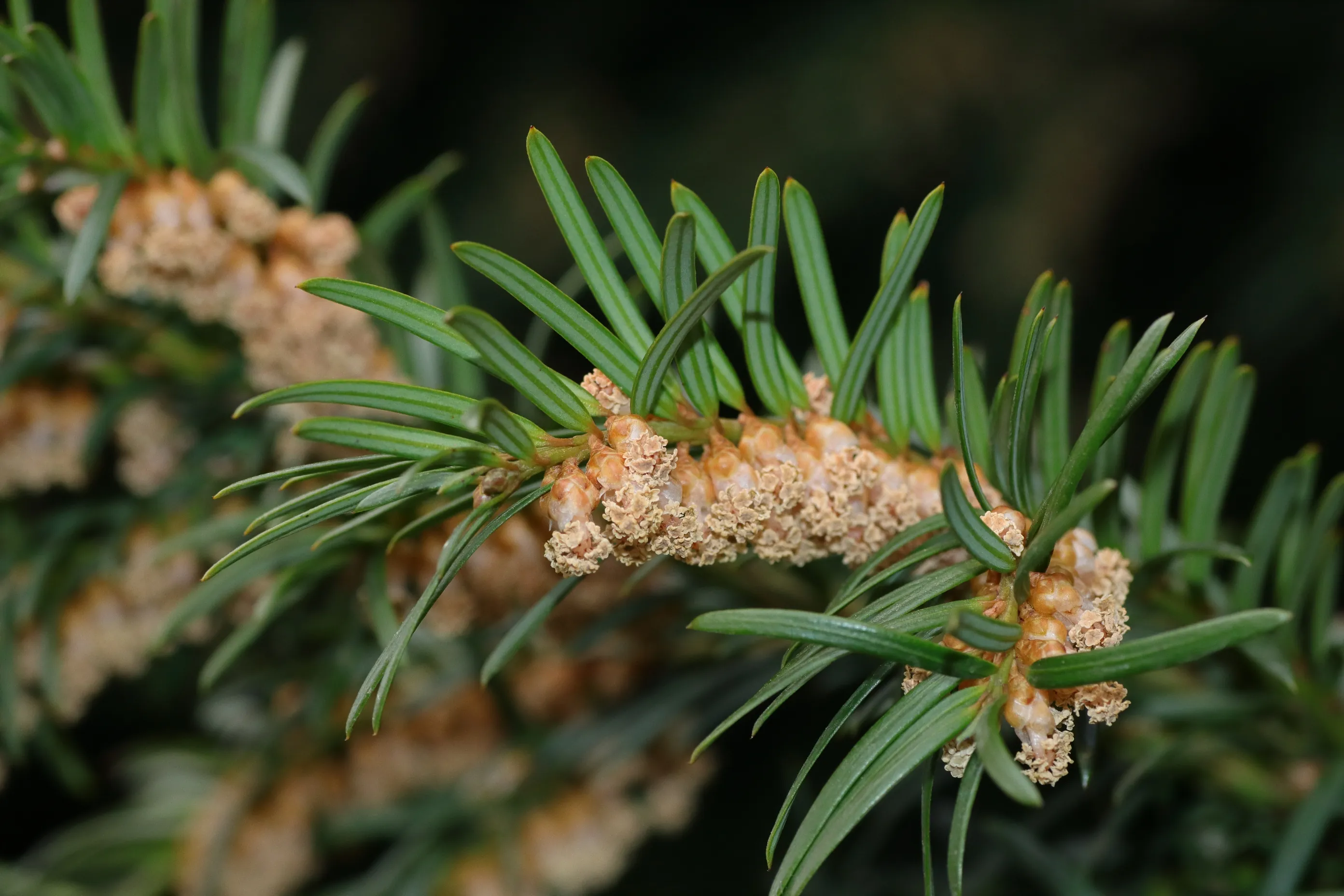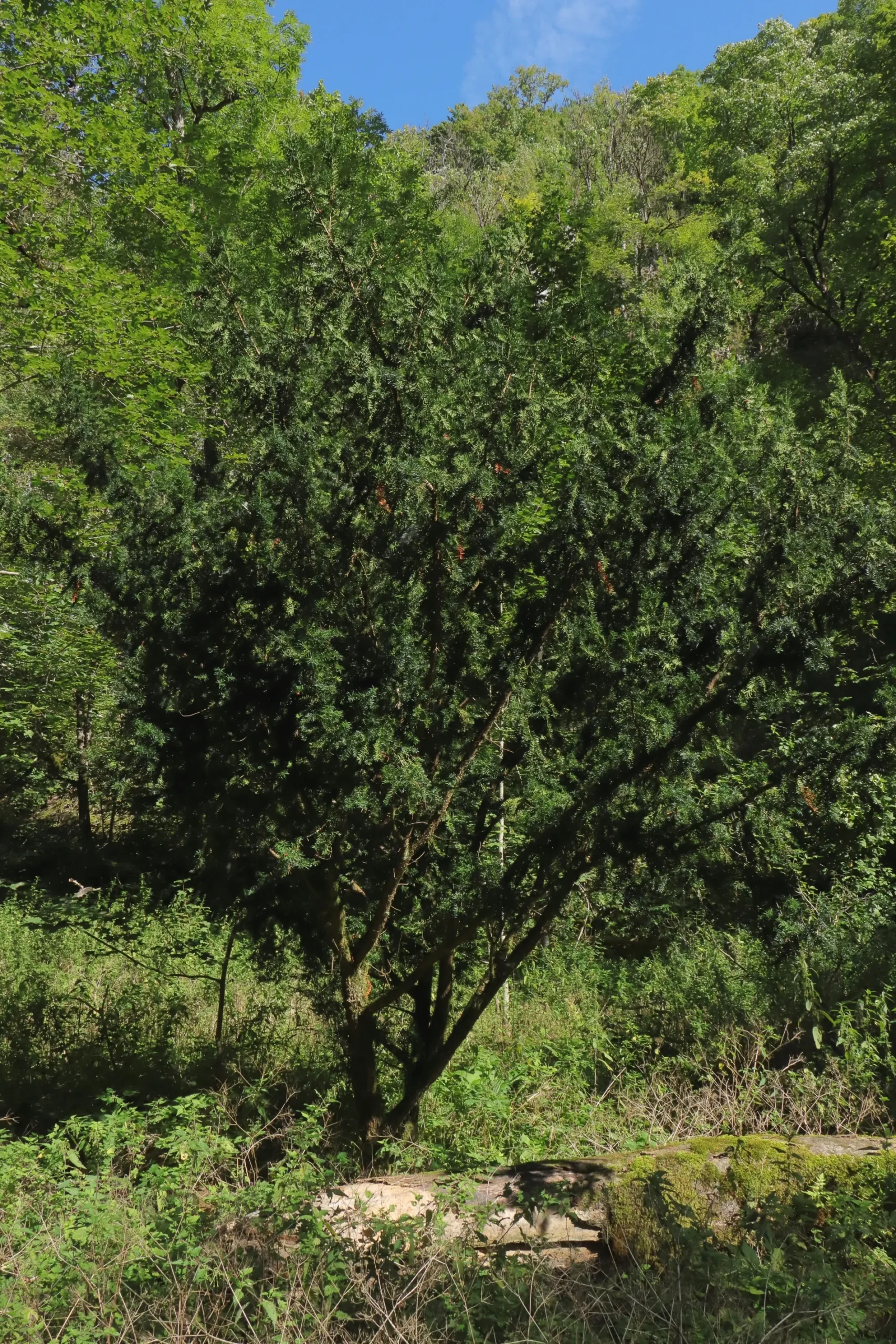The european yew is an evergreen tree with conspicuous red fruits, which is especially popular with birds. Despite it’s beautiful appearance, it is a very highly poisonous tree in all parts.
~ Tree of the Year 1994 / Poisonous Plant of the Year 2011 ~



~ Strong poisionous plant ~
Occurrence and distribution: The european yew grows naturally mainly in the Alps and in the foreland of the Alps. In central Germany it is scattered as a wild plant. In the north-east and north of Germany, the european yew is very rare. The tree is often planted as an ornamental plant in parks, gardens and cemeteries. In part, the european yew can be used as a hedge in the form of a garden hybrid. It has a natural distribution in Central and Southern Europe as far as the Caucasus as well as into Asia and North Africa. The tree is mainly found in shady forests. In the mountains, the european yew can be found at altitudes of up to 1,200 metres.
Slow growth: The european yew has a very slow growth due to the often very shady locations (1 to 3 cm per year). If the light conditions change too quickly, the needles can suffer sunburn. Due to the slow growth, the european yew can become very old with up to 1,000 years.
Plant description
Growth habit: The tree usually consists of several trunks and often reaches a trunk diameter of up to 50 cm per individual trunk. The european yew reaches a height of between 5 and 12 metres (rarely up to 20 metres). The trunks have a grey-brown (fresh: red) bark. This often flakes off the tree in flat pieces of bark. Old specimens have rough bark. The tree crown is still conical when young (wider at the bottom than at the top), later it becomes rounded / spherical.
Needles: The needles sit opposite of each other on the branches of the tree. The individual needles have a length between 1.5 and 3 cm. On the upper side the needle is dark green, glossy in colour. The underside has a grey-green, matt colour. They are marked with three darker stripes. The edges are smooth and taper to a point at the end or are rounded.
Flowers: There are purely female and purely male flowers on the european yew. The male flower buds are roundish and have a short stem. They are only about 4 mm in size and are yellowish in colour. The male flowers consist of scale petals as well as 6 to 14 stamens with pollen sacs. The female flowers are only about 2 mm in size and sit in the axils of the needles. A “pollination drop” forms at the end of the female flowers. This allows the male pollen to be intercepted. The flowering time of the european yew is from March to April.
Seed: Six to eight weeks after pollination of the flower, a seed that is black when fully ripe forms from the green-coloured ovary. The individual seed is surrounded by a fleshy seed coat. This is initially green in colour, but changes to a bright red when fully ripe. The seed sits in the centre of the downward-opening false berry. Only one seed is formed per berry. Seed ripening begins in August.
Special characteristics of the plant
Special characteristics of the trunk: Seldom, older trees with a trunk diameter of up to 1 metre can also form. Often, several trees and side shoots join together to form a “pseudo trunk”. This makes age determination very difficult.
Special characteristics of the flowers: The flowers of the european yew are dioecious. This means that the flowers have separate sexes. Male and female flowers form on different trees. On one of the two trees, numerous male flowers are situated on the branches. The less numerous female flowers are on the other tree.
Special characteristics of the pollen: The flowering branches of the european yew should not be shaken under any circumstances, as this releases the pollen of the plant stored in the male flowers in large quantities. Like all other parts of the plant, the pollen grains are poisonous and cause rashes and swellings when they come into contact with the skin. This does not only affect allergy sufferers! But especially these people should avoid flowering european yews.
Special characteristics of the seed: The red “flesh” is botanically called the aril. This is a special form of outer shell that surrounds a seed. The seeds are mainly dispersed by animals in the form of so-called zoochory. What is special about this is that it is endozoochory by birds. The seeds are eaten by birds together with the seed coat and excreted undigested by the birds. Starlings, blackbirds, song thrushes and mistle thrushes are among the main spreaders. It is interesting that the nuthatch also carries the seeds away from the trees. However, it does not eat them immediately, but stores them in rock crevices, wall joints and bark cracks. These are then supposed to serve the nuthatch as winter food. The birds do not poison themselves by eating the seeds, as they are not broken / digested!
Strong poisonous plant – tips for handling
General toxicity of the plant: All parts of the plant (except the red coloured flesh) are very poisonous. Therefore, special care should be taken when handling the plant. Gloves should definitely be worn when cutting the plant. The green cuttings should not be used on your own compost heap, as the sap of the branches, twigs and needles contains toxins. If there are children living in the household, do not plant a european yew, as the bright red pseudo berries with the black seeds could be collected by children. Eating the flesh of the fruit is not dangerous in itself, but chewing the seeds releases the toxins!
Poisonousness for animals: In the case there are pets in the household, care should be taken that they do not come into contact with the plant, as the yew needles also release toxins when chewed. Horses and sheep in particular are very susceptible to yew poisoning. It is therefore important to ensure that there are no yew trees near the meadow. The plant is also not suitable as fodder for cows, pigs and poultry.
European yew tree poisoning
Contents: taxin B, baccatin III, biflavonoids, phenols, taxacins, betuloside, paclitaxel. The ingredients are not destroyed by drying!
LD50 for animals: horses and sheep – 100 / 200g needles, cows – 500g needles, pigs – 75g needles, poultry – 30g needles, dogs – 30g needles
LD50 for humans: Small amounts of the chewed needles or seeds.
Symptoms of poisoning with european yew: The first symptoms of poisoning after ingesting parts of the plant may appear after more than one hour. These include: Nausea, dizziness, unconsciousness, stomach pain as well as dilatation of the pupils. In addition, cardiac and circulatory disorders may occur. The toxin has an initially excitatory and later paralysing effect on the central nervous system and the lungs. This is mainly shown by tachycardia (strong acceleration of the heartbeat), later bradycardia (strongly slowed heartbeat). Liver and kidney damage and seizures may also occur. Death occurs without treatment due to heart failure or respiratory paralysis.
First aid for poisoning with european yew: Seek medical attention immediately. Self-treatment can significantly worsen the condition. Professional poison removal by medical personnel is strongly recommended. It is strongly advised not to take activated charcoal on one’s own.
Folk names
Folk names: The european yew is known by various folk names. Among these are bow tree (Bogenbaum), Ibe, Neib, cross-rods (Kreuzruten) and death tree (Totenbaum) or churchyard tree (Kirchhofsbom). The German name “Bogenbaum” (bow tree) can be derived from its earlier use for making bows and crossbows. The wood of the european yew is hard but at the same time elastic. Nowadays, it is still partly used in woodturning, carving and for making musical instruments. Especially in the Renaissance, the lute was made from the wood. In the Middle Ages, the european yew was almost completely wiped out in southern Germany.
The Swabian name “Ibe” is a shortening of the name Eibe (european yew). The european yew is called “cross-rods” (Kreuzruten) because the palm bosques were decorated with branches of the european yew. These were put behind the crucifix in the living room after the blessing.
The name Totenbaum ” (death tree) or “Kirchhofsbom” (churchyard tree) derives from the practice of planting european yews in cemeteries and around churches. It was already considered a “deadly plant” in earlier times because of its toxicity.
Name origin
Name origin: The botanical genus name “Taxus” is derived from the Latin word “taxus”. This is actually the Latin name for the plant. Dioscurides called the european yew σμῖλαξ (milax). In his writings, however, he acknowledges that the Romans called the plant τάξος (taxos). A further etymological origin cannot be proven. One possible derivation is in the ancient Greek word “τόξον” (bow), since apparently its use as a material for bows was already known at that time. Another possibility is “τάξις” (order), as the needles are regularly distributed on the branches. The botanical species name “baccata” refers to the berry-bearing branches of the european yew.
Origin of the German name: The german name “Eibe” (yew) is derived from the Old High German “iwa” and the Middle High German “iwe”. Hildegard von Bingen refers to the tree as the “yew tree”.
Myths about the european yew tree
Myths about the yew: For the Germanic tribes, the european yew was a sacred tree. They dedicated their “ihwaz rune” to the tree. The yew was supposed to ward off illness and disaster. Yew trees were also planted in many sacred places.
Endangerment of the plant
Endangerment of the plant: The european yew is already classified as potentially endangered on the Red List of Germany. The natural occurrences of the plant are endangered in almost all of Germany. European yew is therefore also considered endangered on the regional Red Lists of the federal states. The individual endangerment levels are as follows:
- Baden-Wuerttemberg: endangered (status: 3)
- Bavaria: endangered (status: 3)
- Berlin: extinct (status: 0 – end of 18th century)
- Brandenburg: extinct (status: 0)
- Bremen: endangered (status: 3)
- Hamburg: extremely rare ( status: R – neophyte)
- Hessen: not endangered (status: *)
- Mecklenburg-Western Pomerania: pre-warning level (status: V)
- Lower Saxony: endangered (status: 3)
- North Rhine-Westphalia: endangered (status: 3)
- Rhineland-Palatinate: endangered (status: 3)
- Saarland: unknown – not included in Red List!
- Saxony: threatened with extinction (status: 1)
- Saxony-Anhalt: extremely rare ( status: R)
- Schleswig-Holstein: inconsistently represented (status: U)
- Thuringia: not endangered (status: *)
Distribution-codes: A, AV, M1, (M2, F, K)